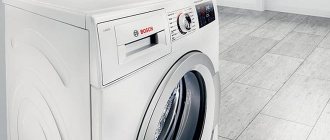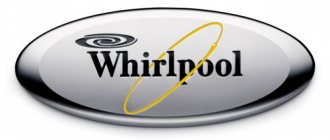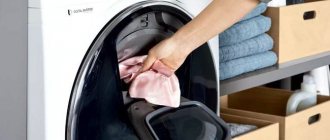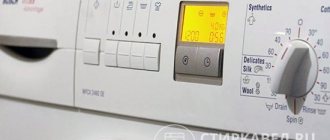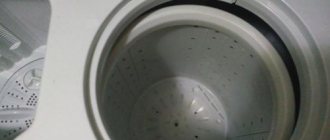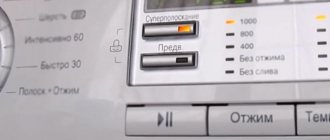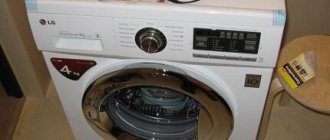Malfunctions of Ariston washing machines can cause equipment owners to worry, although not often. Compared to competing brands, Aqualtis series machines, as well as other Ariston models, break down less often. The Ariston brand, along with such brands as Indesit, HotPoint and Stinol, belongs to one of the largest manufacturers of household appliances - the Italian concern Indesit Company. Automatic washing machines (hereinafter also referred to as SM, SMA) of this brand have gained trust and popularity among customers due to their high quality and reliability.
HotPoint Ariston Aqualtis - a series of modern “intelligent” washing machines
We recommend looking for spare parts for washing machines in Sevastopol on this website.
Common breakdowns
All possible malfunctions of the washing machine can be divided into several groups:
- Doesn't turn on.
- Doesn't drain water.
- There is no spin.
- Does not open.
- No heating.
- Leaking.
- Doesn't take up water.
- Makes extraneous noise.
There may be several reasons for each of the listed malfunctions. For example, the lack of water in the tank can be due to either a broken inlet valve or a simple clog in the inlet hose.
Before you start repairing the Hotpoint-Ariston washing machine yourself, you need to determine the probable causes of the problems and possible methods for eliminating them.
Doesn't turn on
Possible reasons why the washing machine does not work when turned on:
- the socket or power cord is faulty;
- The control module is damaged.
It’s easy to check the serviceability of the outlet - just plug in another, working device. Damage to the cord can often be seen visually, by testing the cable with a multimeter to be sure. If there is no resistance between the “start” and “end”, the cord should be replaced with a new one.
Only a specialist can troubleshoot the Ariston Hotpoint module. The cause of failure may be a sharp surge in voltage in the network. Reflashing or replacing a module is an expensive procedure.
In some cases, after being plugged in, the machine signals that it is ready to work (the indicators light up), but after selecting a program, the washing does not start. There may be several reasons for this:
- The inlet hose is clogged or the valve is faulty. The appliance cannot start due to lack of water.
- The electric motor burned out. Most likely, in this case, the machine will fill with water, but the washing process will not advance further. As a rule, a breakdown is accompanied by extraneous noise.
Removing a blockage at the inlet is quite simple. To do this, you need to remove the inlet hose, wash it under pressure, and clean the inlet filter mesh with a brush.
Replacing a faulty valve proceeds according to the following scheme:
- The inlet hose is unscrewed.
- The top cover is removed (the 2 bolts on the back wall that hold it are unscrewed).
- The clamps connecting the pipes and the valve are unfastened, and the terminals are removed.
- The valve is pulled out from its seat and washed. After washing, its contacts should be ringed, checking the resistance. If it is missing, the problem is not a blockage, the part has failed and needs to be replaced with a new one.
After installing the new valve, the assembly is assembled in the reverse order and a test run is carried out.
The machine does not drain water
The most common cause of this problem is a clogged drain system. The breakdown may also be due to a failure of the pump or control unit (the drain command is not given).
The process of removing clogs begins with cleaning the filter. The procedure can be represented as follows:
- The filter cover, hidden behind the front panel at the bottom of the facade, opens slightly.
- A flat dish is placed under it to collect the flowing water.
- When the washing solution has completely drained, the filter is completely removed and washed.
If the blockage is severe, not only the filter can become clogged, but also the pump and even the drain hose. If cleaning does not lead to the desired result, it is necessary to check the serviceability of the pump.
Before you begin repairing the Ariston washing machine yourself, you need to dismantle the part in the following sequence:
- Unplug the power cord from the outlet, disconnect the drain and inlet hoses.
- Lay the car on its side and remove the bottom protection.
- Disconnect the terminals, unscrew the clamps on the pipes.
- Unscrew the screws holding the pump (1 or 4 depending on the model).
What you should be wary of:
- the impeller is pushed forward;
- strong backlash;
- a large amount of scale in the filter seat.
To make sure the part is in good condition, you need to check the resistance of the motor windings. If it is absent (the norm is 140–180 Ohms), the pump is faulty and the winding may break. You can check the engine by connecting it to the network. If the pump is working properly, the impeller will begin to rotate.
No spin
There are three main reasons for this malfunction:
- The motor failed and the drum stopped rotating.
- The tachometer, which regulates the speed of rotation of the rotor, is faulty. The engine runs at minimum speed and the spin cycle does not meet the specified parameters.
- The belt is broken.
- Problems with the electronic module.
- The water does not drain and the machine cannot start spinning.
It is very easy to check the last point - just drain the water through the filter or drainage tube and start the spin program.
To check the operation of the engine and the integrity of the belt, you need to remove the back cover of the device by unscrewing the fastening screws. A broken belt can be seen visually, but the motor will have to be examined in more detail.
To check the serviceability of the engine, it is necessary to measure the resistance on adjacent lamellas. It should be the same, within 0.2 Ohm. Sometimes wear on the slats can be seen visually. The part cannot be repaired - the engine must be replaced.
If the problem is not in the motor, you need to check the serviceability of the tachometer. The sensor is located on the shaft immediately behind the engine. It can be inspected and ringed without removing it from its seat.
The device is considered operational if the resistance it produces is about 60 ohms. In this case, you can check its contacts and how well it is secured to the shaft.
The door won't open
There may be several reasons why the hatch was blocked:
- There is still water in the tank and the machine cannot open the door to avoid flooding.
- The door handle mechanism is broken.
- The hatch locking device is faulty.
- Problems with the control module.
Before you begin the repair, you need to open the door by inserting a thin ruler under the hatch and squeezing the tongue or using an emergency cable (it can be found under the filter cover).
A faulty handle does not respond to pressure; if it breaks, it must be replaced with a similar one. The locking device located on the front panel must be removed by first unscrewing the bolts holding it and pulling off the cuff. The part rings and changes in the absence of resistance.
No heating
If the machine washes in cold water, most likely the heating element has become unusable. Replacing it is quite easy.
Troubleshooting proceeds according to the following scheme:
- Remove the front panel.
- Find the heating element at the bottom of the tank and test its contacts with a multimeter.
- If there is no resistance, replace the part with a similar one.
The cause of the breakdown may be accumulated lime or mechanical wear of the heating element.
Leaking
You can determine the location of the leak by observing the washing machine during the washing process. If water appears while filling, the inlet hose is probably damaged. If during reset - drain hose or pipes.
Water that accumulates under the bottom during washing may indicate a leaky tank. If it flows down the front wall from the side of the hatch, it’s all a matter of a leaking cuff.
To restore the tightness of the joints, it is necessary to replace the leaky part with a new one, tightening the joints.
Doesn't take up water
The main reasons why the machine does not take in water:
- clogged inlet hose;
- Fill valve malfunction;
- problems with the control module;
- The pressure switch is faulty - without water it gives a signal that the tank is full.
All of the listed parts except the faulty module can be diagnosed and replaced at home.
The machine makes strange noise
The probable cause of the grinding noise is wear of bearings, shock absorbers, suspension springs, as well as foreign objects getting inside the drum.
Replacing bearings in Ariston vertical washing machines follows the following algorithm:
- The device is disconnected from the electrical network and water supply.
- Unscrew the screws from the back and front that hold the side panel and remove the panel.
- Remove the pulley after first unscrewing the bolt holding it.
- Having reached the hub, unscrew the screws and remove it from the seat.
- Carefully knock out the bearing and seal.
- An oil seal is installed in the hub, the bearing is pressed in, the place where the oil seal comes into contact with the shaft is cleaned and lubricated.
- The hub is installed back, the car is assembled in the reverse order.
The bearing on the other side of the washing machine is changed according to the same principle, only without removing the pulley.
The bearing in front-loading Ariston washing machines changes according to a standard algorithm, like any other machine of this type.
Ariston washing machine error codes
Error codes in the form of symbols on the screen help determine the cause of the failure.
| Error code | Malfunction |
| F01 | Motor circuit short circuit |
| F02 | Problems with the tachometer |
| F03 | Temperature sensor malfunction |
| F04 | The pressure switch responsible for the water level in the tank is faulty |
| F05 | Problems with draining (the pump does not pump or the level sensor does not signal the end of draining) |
| F06 | Problems with the control buttons (in the Dalogic series) or the sunroof locking device is faulty |
| F07 | Malfunction of the pressure switch (heating element without water) |
| F08 | The machine receives a signal that heating has begun when the tank is empty (“pressostat is stuck”) |
| F09 | Device memory problems |
| F10 | The pressure switch does not signal the water level |
| F11 | The drain pump does not respond to module commands |
| F12 | The display module does not receive a signal from the control module |
| F13 | Drying temperature sensor reports an error |
| F14 | The heating element responsible for drying clothes is faulty |
| F15 | Drying does not turn on |
| F16 | An error occurred while parking the drum (for machines with vertical loading) |
| F17 | The hatch door is open |
| F18 | Microprocessor malfunction |
| F20 | An error occurred while drawing water |
In models without a display, a certain periodicity of indicator blinking corresponds to a particular error. Thus, the owner of the washing machine will be able to find out which unit has problems.
If the screen is missing
Automatic Ariston machines that are not equipped with a display signal faults detected by the self-diagnosis system by flashing the display on the control panel. Most washing machine models have only two indicators - a symbol confirming the hatch is locked and a power light. The door lock LED is usually in the form of a lock or key and is always on. When selecting the desired washing mode, the selector knob rotates in a circle, while clicking slightly.
Certain Hotpoint Ariston models indicate breakdowns by flashing the “lock”, the “Spin” light and the “Program End” LED. You can find automatic machines without a display that tell you about an error by showing the temperature indicators at 30°C and 50°C. At the same time, the LED will light up to indicate washing in cool water and indicators 1, 2 and 4 will flash.
Features of AVSL 100 repair
Sometimes owners of AVSL 100 machines encounter problems whose solutions are not so obvious:
- The washing machine interrupts the program before spinning or rinsing. If the device is disconnected from the network and then turned on again, the unit will complete the process. The likely problem is a faulty drain pump that jams from hot water.
- The device freezes during operation and the fault is not detected. After cooling, the washing machine resumes washing. The probable cause is wear of the motor brushes; they need to be replaced with new ones.
In general, malfunctions of washing machines of this series can be considered typical.
The control unit has failed
Recently, washing machines of various brands (including Ariston) are increasingly diagnosed with such a nuisance - a malfunction of the control unit. In most cases, such a breakdown cannot be considered the fault of the machine itself or its user. Rather, the culprit is our electrical grids.
It is very difficult to fight them. It is easier to use protective equipment to connect the washing machine. Replacing an electronic unit is not the biggest problem for a knowledgeable person - it is more difficult to get it.
These possible malfunctions may be typical for automatic washing machines manufactured by Ariston. Of course, the list of various problems may be noticeably wider, but in this case we consider those troubles that can be completely solved on our own and do not always require the involvement of service specialists.
An important addition to the description of ways to solve various problems with Ariston washing machines will be the fact that it was quite possible to prevent their occurrence. And for this it is more than enough to carry out preventive cleaning and maintenance. Surely the washing machine will reward you with long and trouble-free operation.
Features of AVTF 104 repair
Top loading washing machines such as the AVTF 104 have a number of features:
- If water accumulates under the bottom of the machine, not only the tank and various connections may leak, but also the seal at the top.
- An imbalance of the unit can lead to spontaneous opening of the hatch flaps. As a result, the heating element may be knocked down, the doors themselves may be broken, and the tank may be damaged.
- Vertical machines are distinguished from frontal models by the principle of fastening the drum, which is supported on two axle shafts equipped with two bearings. Accordingly, to replace them it is necessary to remove not the rear part of the unit, but the side panels.
It is worth considering that top-loading models are made in Europe, therefore, replacement parts for them are more expensive and less common.
Problems with the door, cold water
One day the user may discover that the hatch does not close. There may be mechanical damage (such as deformed plastic latches) or an electronic failure that is causing the door to not lock. When using the washing machine for a long time, the hinges on which the door is hung may also sag.
A frequent breakdown can be considered the failure of the heating element. If the machine does not heat the water, it is worth inspecting the element. In most cases it will need to be replaced. The heater becomes covered with scale, which provokes its combustion.
Features of the Margarita 2000 repair
This model was sold back in the 2000s, but you won’t see it on store shelves for a long time. However, in some families it still serves faithfully. Despite the outdated design, the model has a standard design.
There are some nuances during dismantling - the powder receiver of this washing machine does not extend forward, but rotates 450 degrees clockwise, so in addition to the standard two horizontally inserted screws, it is held in the desired position by another vertical one.
Margarita 2000 has a mechanical control; when a malfunction is detected, the command device begins to rotate clockwise. The frequency at which the “On/Off” indicator lights up will help you navigate current malfunctions.
The number of blinks forms an error code, for example, 3 blinks in a row corresponds to F03, two blinks – F02, etc. The pause between series is 4 seconds.
The model is far from new, so its main malfunctions are associated with long-term operation: wear of the electric motor brushes, failure of bearings, inlet valve, drain pump, heating element.
Setting the washing mode
Initially, the machine is in a standard standby mode, indicated by the “A” indicator, and to start the desired program, you need to use a special command handle.
An indicator in “B” mode indicates that the device is ready to receive a new program, and as soon as it is selected, it is indicated by a “C” indicator. And immediately after that the washing begins. Its execution can be stopped, and to do this you need to turn the program handle to the reset position.
